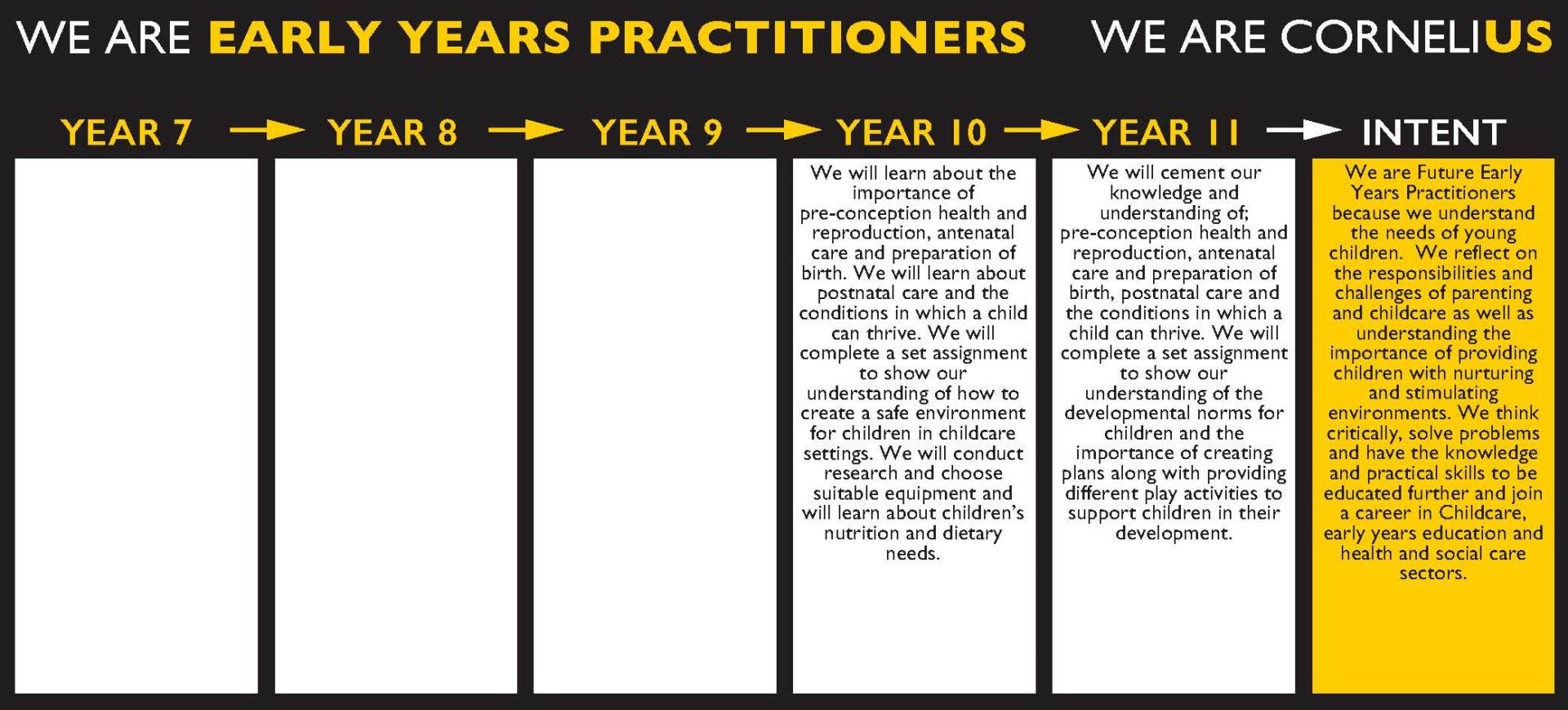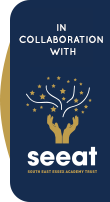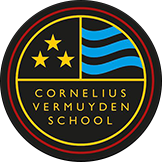Child Development
Intent

Career Opportunities in Child Development
Year 10 Curriculum Overview
Autumn Term
| What are we learning? | What knowledge, understanding and skills will we gain? | What will excellence look like? | How will we recognise progress? |
| R057 Health and Well-being for Child Development | In this unit, students will learn about the importance of being healthy before and during pregnancy and creating conditions in which a child can thrive, including the prevention and management of childhood illnesses and creating a safe environment. Students will begin gaining their knowledge from the preconception stage. They will understand the key factors that impact becoming pregnant, having a healthy pregnancy, and creating a safe and healthy environment for the baby when it is born. | Students will know what factors affect preconception health for men and women. They will know the types of contraception methods and their advantages and disadvantages, the structure and function of the reproductive systems, and the purpose and importance of antenatal clinics and classes, including screening and diagnostic tests. Students will know the choices available for delivery, the methods of assisted birth, and the methods of pain relief when in labour. They will know the signs and stages of labour. Students will know the postnatal checks carried out immediately after birth and the checks within one to five days of birth and can give reasons why. They will know the postnatal care of the mother and baby and the developmental needs of children from birth to five years. Students can recognise signs and symptoms of illness and how to meet the needs of an ill child. They will know how to ensure a child-friendly, safe environment. | Students will answer mock/practice exam questions and papers to gain confidence for the external exam paper in Year 11. They will use teacher and peer assessment comments to independently strengthen their knowledge. The exam is 1 hour and 15 minutes long and has 70 marks. There are 2 sections, comprising short answer and extended response questions. |
Spring Term
| What are we learning? | What knowledge, understanding and skills will we gain? | What will excellence look like? | How will we recognise progress? |
| R058 NEA Creating a safe environment and understand the nutritional needs of children from birth to 5 years Topic Area 1 &2 |
Students will learn how to create a safe environment for children from birth to five years in childcare settings. They will investigate and choose equipment that is both suitable and safe for use. | Students will be able to explain the suitability of each piece of equipment chosen considering the three factors such as Cost, Design, Safety, Durability etc. They will evaluate including why equipment is selected and others are rejected. They will understand the potential accidents and why they happen in the area of the childcare setting. And can justify how to prevent accidents and create a safe environment in the area of the childcare setting. | This is one of the two NEA units Students complete comprising of a portfolio of evidence to meet the topic area for the unit. All NEA Units are internally marked by the teacher. Using the OCR marking criteria. The marks for both NEAs are added to the Exam mark to give an overall mark for the qualification. Each NEA is marked out of 60 and combined make up 60% of the overall grade. Grades are awarded as Level1 Pass, Merit, Distinction, Level 2 Pass, Merit, Distinction and Distinction* |
Summer Term
| What are we learning? | What knowledge, understanding and skills will we gain? | What will excellence look like? | How will we recognise progress? |
|
R057 Revision for Final Exam in Year11 Recap and revise Health and Well-being for child Development. |
In the Autumn term Year 10 students already learnt the following and will continue to recap and revisit:
-Pre-conception health and reproduction -Antenatal Care and preparation for Birth
-The postnatal checks, postnatal care and the condition for development.
-Childhood illnesses and a child safe environment. |
Students will be able to recall: -The purpose and importance of antenatal clinics and classes. -Screening & Diagnostic Tests - Choices available for delivery and role of the birth partner -Methods of pain relief and signs labour has started -The 2 stages of labour and the methods of assisted birth. -The postnatal checks Immediately after birth and within 1-5 days of birth. -The role of the health visitor and mother's six-week postnatal check. -The developmental needs of children 0 to 5 years. -The signs and symptoms of child illnesses and how to meet their needs. -How to ensure a child friendly, safe environment. |
They will use teacher and peer assessment to practice answering short and extended questions.
Starter activities will focus on one practice exam question
A brief test of knowledge will be used at the end of every lesson using different methods. |
|
Coursework R059
Understanding the development of a child from 1-5 years
This is part of the first Task for R059 Coursework and will be continued in Autumn term Year 11
|
Students will have a good understanding of how Children develop, Physically, socially and intellectually.
Students will learn the expected developmental norms for children one to five years. |
Your child can confidently give examples of physical, Intellectual and social development norms for children one to five years. |
The final deadline for submission for the entire R059 Coursework is at the end of Autumn term 2025.
Students' progress will be regularly monitored and checked using the marking criteria.
They must work independently and use their own initiative to make improvements.
Students must avoid plagiarism by producing their own work. |
Year 11 Curriculum Overview
Autumn Term
| What are we learning? | What knowledge, understanding and skills will we gain? | What will excellence look like? | How will we recognise progress? |
| R057 Health and Well-being for Child Development. Topic Areas 3 and 4. |
In this unit, students will learn about postnatal checks, postnatal care, and the conditions for development. They will also learn about childhood illnesses and creating a child-safe environment. | Students will know the postnatal checks immediately after birth and within one to five days of birth. They will know the role of the health visitor and the mother's six-week postnatal check. They will know the developmental needs of children from zero to five years. Students will learn to recognise the signs and symptoms of childhood illnesses and how to meet their needs. They will know how to ensure a child-friendly, safe environment. |
Students will answer mock/practice exam questions and papers to gain confidence for the external exam in their final exam in May 2025. They will use teacher and peer assessment comments to independently strengthen their knowledge. The exam is 1 hour and 15 minutes long and has 70 marks. There are 2 sections, comprising short answer and extended response questions. |
| R058 NEA Creating a Safe Environment and Understanding the Nutritional Needs of Children from Birth to 5 Years. |
Students will learn how to create a safe environment for children from birth to five years in childcare settings. They will investigate and choose equipment that is both suitable and safe for use and will learn about their nutrition and dietary needs. |
Students will be able to explain the suitability of each piece of equipment chosen, considering the three factors evaluated, including why equipment is selected and others are rejected. They will understand the potential accidents and why they happen in the area of the childcare setting and can justify how to prevent accidents and create a safe environment in the childcare setting.
Students will be able to describe how the two milk formulas meet the nutritional needs of babies from birth to six months. They can describe how the meal choices meet the nutritional needs of children of the relevant age and explain how the meal choices meet the government dietary recommendations.
Students can plan and prepare a meal and demonstrate an understanding of the equipment and ingredients. They will follow safety and hygiene practices. Students will evaluate the preparation and planning of their meal and suggest improvements. |
This is one of the two NEA units students complete, comprising a portfolio of evidence to meet the topic area for the unit. All NEA units are internally marked by the teacher using the OCR marking criteria. The marks for both NEAs are added to the exam mark to give an overall mark for the qualification. Each NEA is marked out of 60, and combined, they make up 60% of the overall grade. |
Spring Term
| What are we learning? | What knowledge, understanding and skills will we gain? | What will excellence look like? | How will we recognise progress? |
| Recap and revise R057 Health and Well being for child Development Topic Area 1,2, 3, 4 |
In this unit, students have learnt about the postnatal checks, postnatal care and the condition for development. They have learnt about childhood illnesses and a child safe environment. They have learnt about the postnatal checks, postnatal care and the condition for development. They will also learn about childhood illnesses and a child safe environment. | Students will revise the postnatal checks Immediately after birth and within one to five days of birth. They. Will revise the role of the health visitor and mother's six-week postnatal check. They will revise the developmental needs of children zero to five years. Students will revise the signs and symptoms of child illnesses and how to meet their needs. They will revise how to ensure a child friendly, safe environment. Students will know the postnatal checks Immediately after birth and Within one to five days of birth. They will know the role of the health visitor and mother's six week postnatal check. They will know the developmental needs of children zero to five years. Students will revise the signs and symptoms of child illnesses and how to meet their needs. They will revise how to ensure a child friendly, safe environment. | Students will answer mock/practice exam questions and papers to gain confidence for the Mock exams and the external exam paper in May 2025. They will use teacher and peer assessment comments to independently strengthen their knowledge. The exam is 1 hour and 15 minutes and has 70 marks. There are 2 sections, comprising of short answer and extended response questions. |



